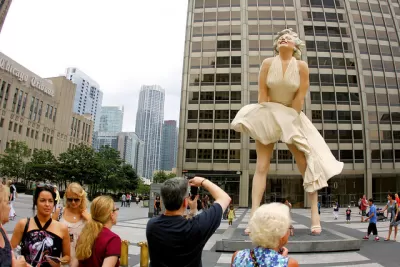"There’s a dramatic difference, Cityfront Center shows, between real estate success and building a great city."

Chicago Tribune architecture critic and Pulitzer Prize winner Blair Kamin writes a large feature story that portrays the Chicago Cityfront Center as a cautionary tale of planning for mega-projects in urban settings.
Kamin's framing of the relevance of the Cityfront Center also makes the case study obviously relevant far beyond Illinois.
Viewed from the air, it’s a stunning transformation — in just 30 years, a gritty swath of cleared land and surface parking lots has become a glistening new part of Chicago.
But people experience cities on the ground, not in the air. Put the 60 acres between Navy Pier and Michigan Avenue under a microscope and what you see is a cityscape of great expectations and half-kept promises.
As for why the project has failed to live up to its promise, Kamin cites some obvious lessons:
Real estate busts, changes in property ownership and the absence of a firm timetable for improvements all share the blame.
So does a lack of effective oversight by the city’s Department of Planning and Development and the City Council’s zoning committee, which were charged with monitoring Cityfront Center.
But as for why those lessons are important important in Chicago, there are several mega-projects looming that have a similar mix of public space and massive scale:
Urban planning flops like these loom large as city officials review new megaplans from developers who pretty up their visions of skyscrapers with dazzling drawings of riverwalks, bike trails and other amenities teeming with smiling, attractive people.
The Chicago Plan Commission is considering the proposed redevelopment of the 25.6-acre Tribune Media site at 777 W. Chicago Avenue today, but there are even larger projects in the pipeline, like the 53-acre Lincoln Yards project on the North Side and a 62-acre project called The 78, located on the Near South Side. "The planner of both [those last two] projects, the Chicago office of Skidmore, Owings & Merrill, co-designed Cityfront Center’s master plan," according to Kamin.
We've only shared the framing for this feature-length article. Kamin goes into fine detail about the ways the Chicago Cityfront Center has failed to live up to its promise. All of this criticism and analysis, with a focus especially on the public realm, is designed to ensure greater success the next time around. "Buzzwords like 'place-led' development mean little without the sharpening of outdated standards for human-scaled streets and vibrant public spaces," Kamin reminds us.
FULL STORY: An Incredible Transformation?

Planetizen Federal Action Tracker
A weekly monitor of how Trump’s orders and actions are impacting planners and planning in America.

San Francisco's School District Spent $105M To Build Affordable Housing for Teachers — And That's Just the Beginning
SFUSD joins a growing list of school districts using their land holdings to address housing affordability challenges faced by their own employees.

The Tiny, Adorable $7,000 Car Turning Japan Onto EVs
The single seat Mibot charges from a regular plug as quickly as an iPad, and is about half the price of an average EV.

With Protected Lanes, 460% More People Commute by Bike
For those needing more ammo, more data proving what we already knew is here.

In More Metros Than You’d Think, Suburbs are Now More Expensive Than the City
If you're moving to the burbs to save on square footage, data shows you should think again.

The States Losing Rural Delivery Rooms at an Alarming Pace
In some states, as few as 9% of rural hospitals still deliver babies. As a result, rising pre-term births, no adequate pre-term care and "harrowing" close calls are a growing reality.
Urban Design for Planners 1: Software Tools
This six-course series explores essential urban design concepts using open source software and equips planners with the tools they need to participate fully in the urban design process.
Planning for Universal Design
Learn the tools for implementing Universal Design in planning regulations.
Smith Gee Studio
City of Charlotte
City of Camden Redevelopment Agency
City of Astoria
Transportation Research & Education Center (TREC) at Portland State University
US High Speed Rail Association
City of Camden Redevelopment Agency
Municipality of Princeton (NJ)



























